2.49" average rainfall, month to date.
74 F. high yesterday in the Twin Cities.
81 F. average high on August 17.
86 F. high on August 17, 2016.
August 18, 1953: Four heifers near St. Martin were lucky; a tornado picked them up and set them back down again, unharmed.
Rare To See Tornadoes and Floods on the Same Day
Wednesday was a poignant, vaguely terrifying reminder that we live in the Super Bowl of Weather. In mere seconds the sky can turn on you. And if you're not paying attention you can get into serious trouble.
Wednesday was a poignant, vaguely terrifying reminder that we live in the Super Bowl of Weather. In mere seconds the sky can turn on you. And if you're not paying attention you can get into serious trouble.
The
storm that squeezed out 2-4 inch rains on the metro, with an
(unofficial) 9.4 inch amount in Redwood Falls, moved very slowly,
allowing storms to track over the same counties; a "train-echo effect".
The same severe storms that spun up as many as 5 tornadoes from Nicollet
to Prior Lake were devoid of lightning. No hail, no lightning, but
torrential, tropical storm-like rains - and a few tornadoes; the result
of intense low-level wind shear? Bizarre.
More
showers and T-storms may bubble up today but the weekend still looks
nice and sunny with highs in the 80s. It'll soon be safe to come out of
your weather-bunker.
The
normally-reliable ECMWF model still pulls a few clouds and showers into
Minnesota on Monday. I know, lousy timing with the eclipse. Keep your
fingers (and eyes) crossed.
Expect comfortable sun the latter half of next week; a nice cool start to the State Fair!
* GOES-16 (non-operational) image above courtesy of NOAA and AerisWeather.
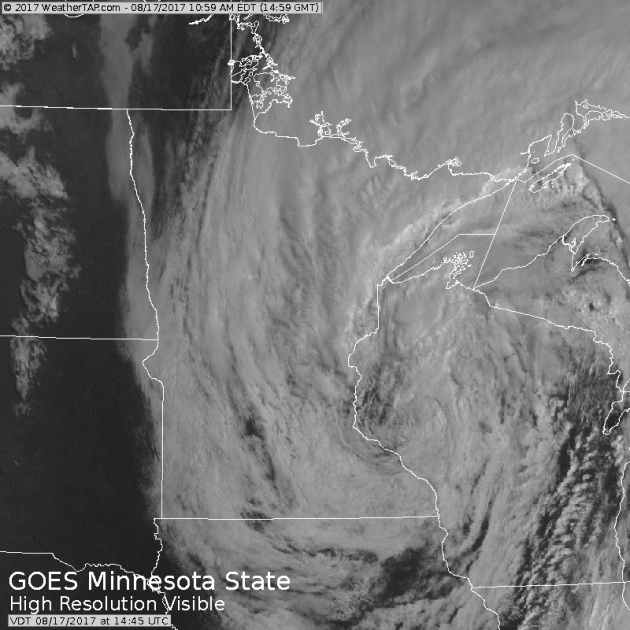
Unusually Intense Storm for mid-August. Wednesday's storm would have felt right at home in mid-October.
7 Confirmed Tornadoes Wednesday Evening.
After on-site surveys the Twin Cities office of the National Weather
Service confirmed a total of 7 separate tornadoes Wednesday. 6 of these
were EF-0 strength, with winds under 85 mph. The tornado that touched
down near New Sweden was estimated to be an EF-1, with winds closer to
105 mph. More details here.
Rainfall As of Early Thursday. Check out this link from NOAA for the latest amounts:
Public Information Statement National Weather Service Twin Cities/Chanhassen MN 732 AM CDT Thu Aug 17 2017 ...24 Hour Rainfall Reports... Location Amount Time/Date Provider Redwood Falls AP 9.45 in 0653 AM 08/17 ASOS Redwood Falls 8.12 in 0630 AM 08/17 COOP Morton 6.82 in 0630 AM 08/17 GOES Beaver Falls 6.47 in 0645 AM 08/17 GOES Maynard 6.07 in 0645 AM 08/17 GOES Bird Island 7SSE 5.88 in 0630 AM 08/17 COCORAHS Searles 5SE 5.54 in 0722 AM 08/17 CWOP Granite Falls 5.26 in 0645 AM 08/17 UCOOP Lucan 4.58 in 0544 AM 08/17 COCORAHS Hanley Falls 4.57 in 0645 AM 08/17 GOES Hanley Falls 4.28 in 0645 AM 08/17 GOES Willmar 5N 4.11 in 0600 AM 08/17 COOP Redwood Falls 3.97 in 0630 AM 08/17 GOES Montevideo 3.91 in 0700 AM 08/17 COCORAHS Lake Lillian 5SE 3.85 in 0645 AM 08/17 COCORAHS Montevideo 1S 3.78 in 0710 AM 08/17 CWOP Montevideo 2SW 3.61 in 0700 AM 08/17 USARMY-COE Montevideo 1SW 3.57 in 0700 AM 08/17 COOP Willmar 2ENE 3.43 in 0713 AM 08/17 CWOP New Ulm 3SE 3.33 in 0423 AM 08/17 COOP New Ulm 3.30 in 0500 AM 08/17 COCORAHS Cosmos 1E 3.15 in 0630 AM 08/17 GOES Providence 3.04 in 0630 AM 08/17 GOES Springfield 1NW 2.94 in 0710 AM 08/17 CWOP St. Martin 1NW 2.92 in 0700 AM 08/17 HADS Stockholm 1S 2.83 in 0615 AM 08/17 USARMY-COE Coon Rapids 2ESE 2.82 in 0710 AM 08/17 CWOP New Prague 1ESE 2.80 in 0907 PM 08/16 COCORAHS Boyd 5SW 2.80 in 0700 AM 08/17 COCORAHS Eden Prairie 2WSW 2.79 in 0700 AM 08/17 COCORAHS Litchfield 3S 2.74 in 0711 AM 08/17 RAWS Brooten 3NNE 2.71 in 0615 AM 08/17 HADS Dawson 2.65 in 0630 AM 08/17 GOES Chanhassen (NWS) 2.62 in 0700 AM 08/17 COOP Brownton 2.60 in 0630 AM 08/17 GOES Long Lake 1NW 2.56 in 0600 AM 08/17 COCORAHS Springfield 2.52 in 0630 AM 08/17 GOES Long Prairie 2.51 in 0600 AM 08/17 COOP Burnsville 3ENE 2.51 in 0620 AM 08/17 COCORAHS Laq Qui Parle Dam 2.50 in 0700 AM 08/17 GOES Little Falls 2SSE 2.47 in 0707 AM 08/17 RAWS Milan 5E 2.31 in 0645 AM 08/17 USARMY-COE Hutchinson 5N 2.29 in 0645 AM 08/17 COCORAHS Burnsville 3SSW 2.24 in 0640 AM 08/17 COCORAHS Frontenac 2.22 in 0645 AM 08/17 UCOOP Prior Lake 2WSW 2.19 in 0716 AM 08/17 CWOP Manannah 2.17 in 0630 AM 08/17 GOES Randall 2.14 in 0701 AM 08/17 CWOP Jordan 2.14 in 0645 AM 08/17 GOES Benson 2.13 in 0645 AM 08/17 GOES Eden Prairie 3ESE 2.12 in 0710 AM 08/17 CWOP Golden Valley 2.10 in 0555 AM 08/17 COCORAHS Lake City 2NW 2.08 in 0718 AM 08/17 CWOP Lake Minnetonka 1WSW 2.08 in 0500 AM 08/17 COCORAHS Chaska 1ESE 2.07 in 0655 AM 08/17 COCORAHS Sobieski 3E 2.07 in 0700 AM 08/17 HADS Shakopee 1NW 2.06 in 0717 AM 08/17 CWOP
Summer Warmth This Weekend - Cooler for the State Fair.
The warming trend advertised for late August is in grave peril as
Canadian air sags southward next week, treating us to a run of 60s and
70s. Sunday will (finally) feel like August. Soak it up. Twin Cities
ECMWF guidance: WeatherBell.
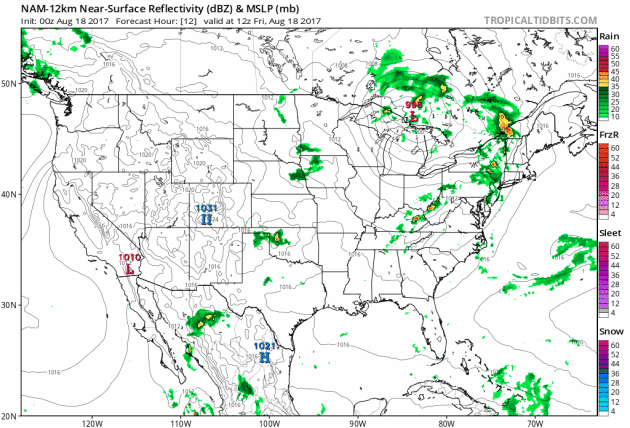
Drying Out.
This has been a very wet pattern for the eastern two-thirds of America,
but models show a drying trend for much of the USA after a sloppy front
slides off the east coast Friday night. A few T-storms flare up over
the nation's midsection over the weekend, with more seabreeze
thunderstorms for Florida. 84-hour NAM guidance: NOAA and
Tropicaltidbits.com.
"Flash Drought" Threatens Crops and Cattle. Just like a flash flood, flash droughts can come on suddenly, often with little warning. Here's an excerpt from High Country News: "...The
current catastrophe began as a “flash drought,” a dry period that comes
on very quickly. Late spring and early summer are typically pretty
soggy in the northern Great Plains — but not this year, says Natalie
Umphlett, regional climatologist and interim director of the High Plains
Regional Climate Center at the University of Nebraska. If the region
doesn’t get enough rain during that critical time, she says, “it’s hard
to make that up...”
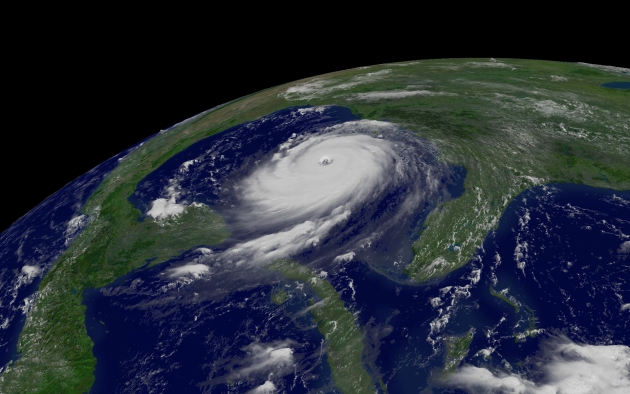
- Seventy-four percent of the deaths related to Hurricane Katrina were among those age 60 and older, and 50 percent of these were among people over age 75, according to a 2006 study.
- In the year after Hurricane Katrina, displaced students in Louisiana public schools, on average, performed worse in all subjects and grades compared with other students. In addition, displaced students experienced a variety of problems related to attendance, academic performance, behavior and mental health, according to a 2010 report..."
Image credit: "Capital Weather Gang’s Angela Fritz explains what could happen to your eyes if you were to watch the Aug. 21 eclipse without special sunglasses and how to spot the ones that work." (Claritza Jimenez, Daron Taylor, Angela Fritz/The Washington Post)
Here's when it will happen in the Twin Cities:
- Starts: Aug. 21 at 11:43 a.m.
- Maximum point in Minneapolis: Aug. 21 at 1:06 p.m.
- Ends: Aug. 21, 2017 at 2:29 p.m.
Photo credit: "A Concorde jet like this one once chased a solar eclipse for over an hour in 1973." Stephen Shankland/CNET.
Farmer's Almanac Outlook for Winter of 2018. Suspend your disbelief; let's light a candle and look out 4-8 months into the future! Good luck with that. Hey, I like to check out the winter outlook as much as anyone else, but please don't refer to this as a forecast or even a trend. There's no peer-reviewed science explaining the methodology involved, and the track record isn't particularly good. But it's fun to look at. Kind of like fantasy football - for weather: Here's an excerpt of a summary from Farmers' Almanac: "...Cold conditions are back! According to the Farmers’ Almanac’s 200-year-old formula, this winter is expected to be a bit more “normal” as far as the temperatures are concerned, especially in the eastern and central parts of the country–chiefly those areas to the east of the Rocky Mountains–with many locations experiencing above-normal precipitation...Break out the space heaters, umbrellas, and warm socks, because the Southeast will see below normal winter temperatures with an unseasonable chill reaching as far south as the Gulf Coast, with above-average precipitation. From the Great Lakes into the Northeast, snowier-than-normal conditions are expected. We can hear the skiers, boarders, and snowmobilers cheering from here!..."
Graphic credit: "People and pets bitten by fleas from dead animals are at risk for contracting plague, health officials say. Cats can become very ill and directly infect humans by coughing infectious droplets into the air. Dogs are less likely to get sick, but they can carry fleas into the home." (U.S. Centers for Disease Control and Prevention).
We Saved the Ozone. Here's How We Can Save Everything Else. GOOD describes international efforts to ban harmful chemicals. The climate challenge is much more daunting, since it requires a reduction in the fossil fuels that still largely power the world: "...In the ’80s, climate scientists realized CFCs and HCFCs – heat-catching chemicals most commonly used as refrigerator coolants – were tearing holes in our planet’s atmosphere. The Montreal Protocol drew upon this evidence to enact laws that would have global repercussions, but it wasn’t until this latest study the rest of us learned about the benefits the United States has since incurred. Head researcher and study writer Lei Hu used the National Oceanic Atmospheric Administration’s atmospheric monitoring network to determine that eliminating these pollutants had the same effect as cutting carbon dioxide emissions by 170 million tons each year from 2008 to 2014. Hu and her team further estimated that maintaining the Montreal Protocol could help the U.S. cut an additional 500 million tons of CO2 by 2025 – that’s about a quarter of the emissions we need to cut in order to fulfill the Paris climate agreement, Gizmodo reports..."
Photo credit: "Hyundai Motors’ new hydrogen fuel cell vehicle is displayed during a media preview in Seoul, South Korea, Thursday, Aug. 17, 2017. Hyundai Motor says its new hydrogen fuel cell vehicle will travel more than 580 kilometers (360 miles) between fill-ups." (Lee Jin-man/Associated Press).
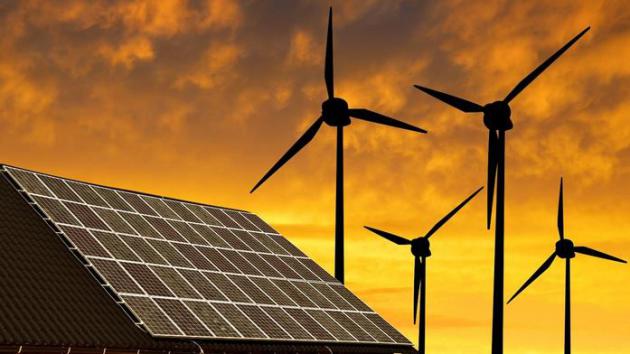
- America produced almost eight times as much electricity from sun and wind as we did in 2007, and those two sources combined to produce 10 percent of the nation’s total for the first time in March.
- At the same time, the country is using nearly 10 percent less energy per capita than a decade ago. Nearly all of that decline was in fossil fuels: In 2007, fossil fuel consumption (PDF) was 85.927 quads, compared to 2016 when it was 78.569.
- Breaking it down further, solar produced 43 times more power than 10 years ago, while wind produced seven times as much..."
Beer Is The Greenest Beverage. I'll drink to that. Nexus Media has the story: "...Some beer makers have found creative ways to conserve resources. In Hawaii, where freshwater supplies are limited, Kona Brewing uses condensation collected
from its air conditioner to water the habaneros and chives used in its
small-batch beers. In Alaska, dairy farms are hard to come by, so
instead of selling its used malt as cattle feed, Alaskan Brewing uses its spent grain to fuel a steam boiler. Magnolia Brewing and 21st Amendment in San Francisco, by contrast, send their leftovers to ReGrained,
a startup that turns old malt into beer-themed snack bars. Since even
the most efficient breweries generate a certain amount of waste and
pollution, some beer makers have sought ways to compensate. Last year, Brooklyn Brewery worked with the Arbor Day Foundation
to plant trees across hundreds of acres of the Mississippi Alluvial
Valley. The trees will soak up carbon dioxide, offsetting pollution
generated by the brewery’s Williamsburg, Brooklyn operation..."
Photo credit: "Solar panels at Sierra Nevada’s California facility." Source: Sierra Nevada.
Photo credit: "Glittering future." (Reuters/Carlos Barria)
Image credit: "The ‘bothie’ Dual Sight function on the new Nokia 8." Photograph: John Nguyen/Press Association.
Photo credit: "A cashier, left, checks out items as a customer shops during the grand opening of the Whole Foods supermarket in Newark, New Jersey." Photograph: Julio Cortez/AP.
Photo credit: Alejandro Alvarez/News2Share via Reuters.
Birthday Thoughts From My 87-Year Old Father. My dad grew up in Germany as WWII was coming to an inglorious, devastating end. As such he had a few thoughts for my WCCO Radio co-host, Jordana Green. Thanks Dad, and happy birthday.
Image credit: "Dubrovnik as King's Landing." HBO.
Map credit: Highcharts.com.
Photo credit: Cait Oppermann.
Photo credit: Bethan Mooney for TIME.
If you are lower in relationship power and have different brand preferences than your partner, you're probably going to find yourself stuck with your partner's favourite brands, over and over again.The researchers used brand preferences in soda, coffee, beer, chocolate, and cars to study individuals and couples over the course of two years. They found the results aligned with findings about relationship power and happiness, and although not seen as important conventionally, could weigh down a relationship. Brick said.."
This could lead to a death-by-a-thousand-cuts feeling.
Most couples won't break up over brand incompatibility, but it leads to the low power partner becoming less and less happy.
Image credit: Yannis Behrakis / Reuters.
Who Needs "Books" When You Can Gaze Up At Statues? Check out this Twitter thread.
TODAY: Patchy clouds. few showers, possible T-storm. Winds: SW 5-10. High: 76
FRIDAY NIGHT: Showers taper. Low: 61
SATURDAY: Partly sunny and pleasant. Winds: SW 5-10. High: 81
SUNDAY: Warm sun, feels like August again! Winds: SW 8-13. Wake-up: 66. High: 86
MONDAY: Few showers and T-storms. Touch and go for seeing eclipse. Winds: S 10-15. Wake-up: 68. High: 82
TUESDAY: Wet start, then gradual clearing. Winds: N 10-15. Wake-up: 66. High: 80
WEDNESDAY: Mix of clouds and sun, comfortable. Winds: NW 7-12. Wake-up: 62. High: 77
THURSDAY: Cool sun for Day 1 of State Fair! Winds: NE 7-12. Wake-up: 58. High: 74
Climate Stories...

Photo credit: "Thousands of protestors gather in Denver Civic Center Park at the People’s Climate March on Denver on April 29, 2017 in Denver, Colorado." Credit: Marc Piscotty / Stringer.
Does Climate Change Cause Extreme Weather Events? A warmer climate correlates with hotter heat waves, more intense rainfall and deeper, more severe drought - but a causal connection with other forms of extreme weather isn't always possible. Here's an excerpt from Smithsonian.com: "...Thanks to advances in supercomputing and pooling hundreds of climate models developed by researchers across the world, they are also more statistically confident than ever in saying that intense storms, droughts and record-breaking heat waves are occurring with increased frequency because of humans. “Ten years ago we wouldn’t have been able to do so,” says Ken Kunkel, a climate scientist at North Carolina State University who also works with the National Oceanic and Atmospheric Administration. But teasing apart individual weather events is harder. The planet’s history is dotted with unexpected, prolonged heat waves and sudden damaging storms far before humans began pumping out greenhouse gases. “The big challenge is that these kind of extreme events have always happened,” says Kunkel, whose work focuses on heavy storms that cause considerable damage in the U.S. But, he says, “Can you say, ‘This event was caused by global warming? No...'”
File image: "A
NASA image of Hurricane Sandy moving along the United States' East
Coast. Extreme weather events like this are becoming more frequent, but
scientists still face challenges when attributing any one storm to
climate change." (NASA / Alamy)
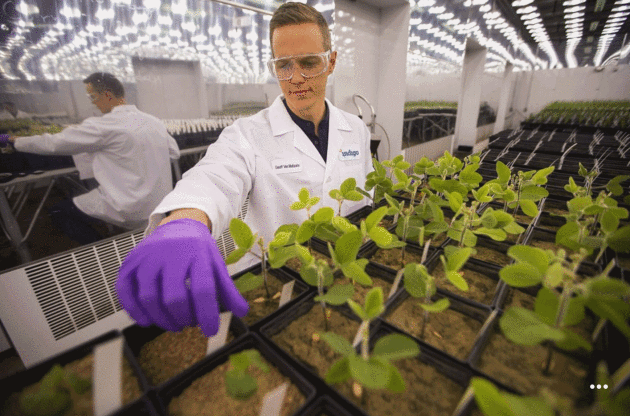
Boston Startup Hopes Its Seeds Will Help Farmers Cope with Climate Change. WBUR-FM has an interesting story that focuses on agricultural resilience: "...Indigo's
goal is simple, albeit lofty: to help farmers sustainably feed the
planet. To do that, it's working to create drought-resistant seeds
coated with tiny microbes.
"Every plant in the world appears to have microbes living on the
insides of its tissues, and those microbes can be little bacteria, they
can be little fungi, they can be combinations of the two," explained
Geoff von Maltzahn, a co-founder of Indigo and a partner at Flagship.
These plant/microbe partnerships have taken place naturally over
millions of years of evolution, and so von Maltzahn wondered: If
certain plants were able to survive a drought better than others, maybe
that tolerance was coming from the plant's microbiome..."
Photo credit: "Indigo
Agriculture's goal is simple, albeit lofty: to help farmers sustainably
feed the planet. To do that, it's working on creating drought-resistant
seeds coated with tiny microbes. Here, Geoff von Maltzahn, the
co-founder of Indigo, checks on the plants in the company's grow room at
its Charlestown headquarters." (Jesse Costa/WBUR)
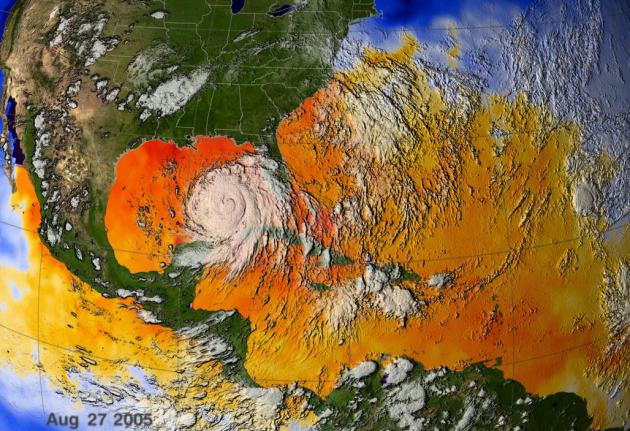
Case for Climate Change Grows Ever Stronger. Here's the intro of an Op-Ed from the Editorial Board at USA TODAY: "Could
proof grow any more powerful that humanity is responsible for a
dangerously warming planet? Scientists studying Earth's atmosphere and
oceans are finding ever more troubling evidence. Last year was the
hottest on record, according to a report late last week from the
National Oceanic and Atmospheric Administration. The report, by more
than 450 scientists from 60 nations,
also found that greenhouse gases in the atmosphere and global sea
levels are at their highest levels on record. Just as troubling were
draft findings destined for the quadrennial National Climate Assessment.
Scientists from 13 federal agencies found that a rapid rise in
temperatures since the 1980s in the United States represents the warmest period in 1,500 years..."
No comments:
Post a Comment